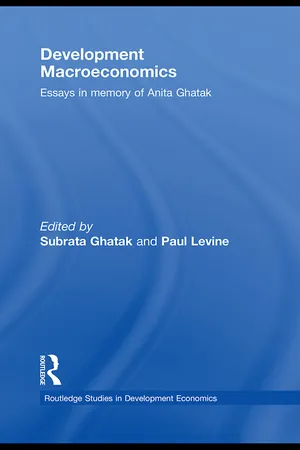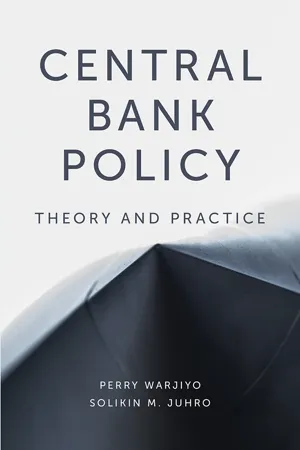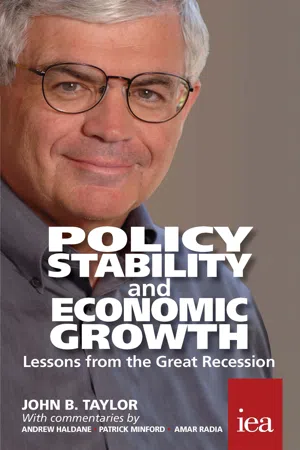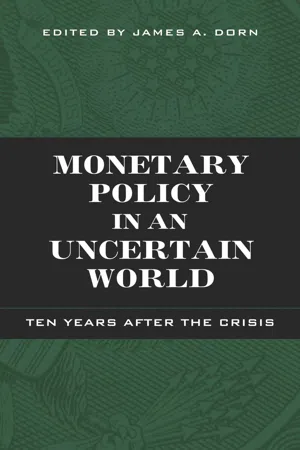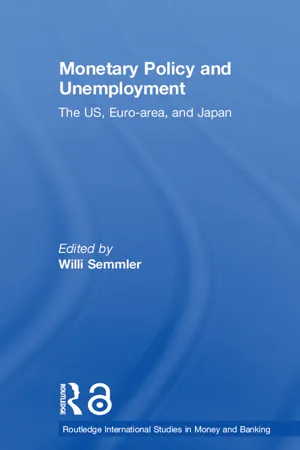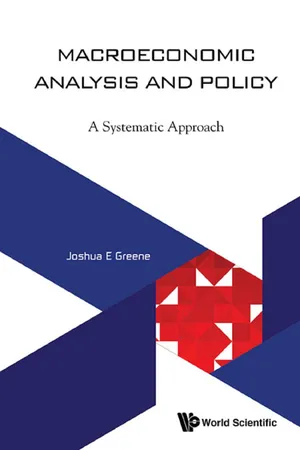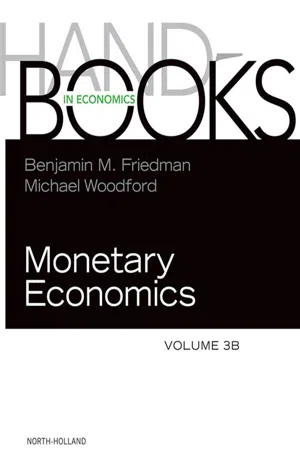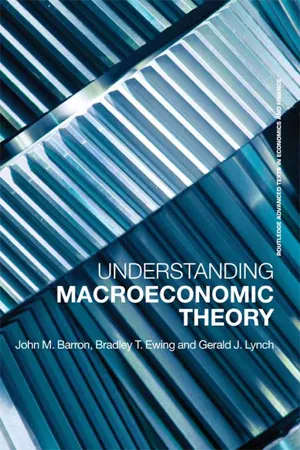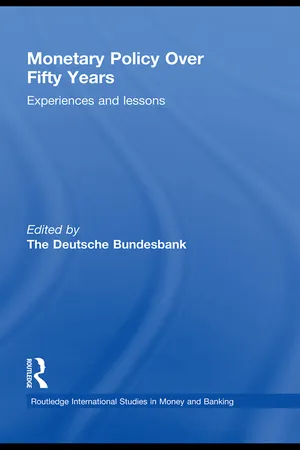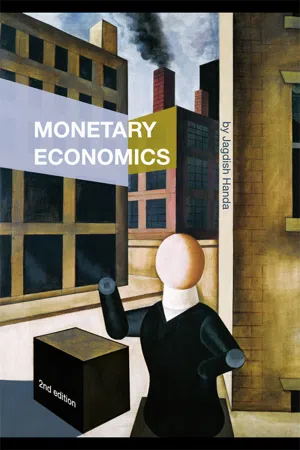Economics
Rule Based Monetary Policy
Rule-based monetary policy refers to a framework in which central banks follow predetermined guidelines or rules to make decisions about interest rates and money supply. This approach aims to provide transparency and predictability in monetary policy, reducing the potential for discretionary actions that could lead to economic instability. By adhering to specific rules, central banks seek to anchor inflation expectations and promote long-term economic stability.
Written by Perlego with AI-assistance
Related key terms
12 Key excerpts on "Rule Based Monetary Policy"
- eBook - ePub
Rules for International Monetary Stability
Past, Present, and Future
- Michael D. Bordo, John B. Taylor, Michael D. Bordo, John B. Taylor(Authors)
- 2017(Publication Date)
- Hoover Institution Press(Publisher)
Chapter Six Rules-Based International Monetary Reform John B. Taylor, Richard Clarida, and George P. Shultz PART 1 An International Monetary System Built on Policy Rules and StrategiesJohn B. Taylor1For nearly two decades in the 1980s and 1990s, economic performance and stability improved in major parts of the world as monetary policy tended to be more focused and rules based. During much of the past decade, monetary policy has deviated from a rules-based approach in much of the world, and economic performance and stability has deteriorated, remaining poor today. As Paul Volcker (2014) has put it, “the absence of an official, rules-based, cooperatively managed monetary system has not been a great success.”In these remarks I discuss a new approach to international monetary policy. The proposed reform is based on years of experience and economic research which suggest that a rules-based reform in each country will deliver a rules-based international monetary system that “can better reconcile reasonably free and open markets with independent national policies [and] stability,” the sensible goal called for by Volcker (2014).I start with a review of the economic principles that indicate that such a rules-based policy will lead to good global economic performance. I then provide evidence—consistent with those principles—that shows that adhering to more rules-based policy has been associated with good performance while deviating from rules-based policy has been associated with poor economic performance. Building on this experience and the principles, I then describe the reform proposal and its implementation.The international monetary system: A rules-space or strategy-space approachEconomic research going back to the 1980s showed that simple rules-based monetary policy would result in good global economic performance (Carlozzi and Taylor 1985; Taylor 1985). In this research, the monetary policy of each central bank was viewed as a rule or strategy for the instruments of policy, and questions of international coordination or cooperation were addressed in “rules-space” or “strategy-space” rather than in terms of the setting for the policy instruments. If each central bank adopted a rules-based monetary policy that was optimal for its own country’s price and output stability, it would contribute to global stability. Moreover, there would be little additional gain from the central banks also jointly optimizing their policy rules or strategies. In other words, the research showed that the Nash equilibrium—where each country chose its monetary strategy taking as given other countries’ strategies—is nearly optimal, or nearly an internationally cooperative equilibrium. - eBook - ePub
- Subrata Ghatak, Paul Levine(Authors)
- 2009(Publication Date)
- Routledge(Publisher)
In particular, when considering monetary policy rules for transition economies, the following major issues arise:A question that arises is whether the Taylor rule is also a useful guide for monetary policy in transition economies. It should be noted that the Taylor rule does not take direct account of shocks, which one would expect to occur more prominently in transition economies than in developed economies. Still, Taylor rules have many of the same advantages in transition economies as they have in developed countries. In particular, for transition economies that do not choose a policy of a “permanently” fixed exchange rate (perhaps through a currency board or through a common currency, i.e. dollarization), a sound monetary policy should be based on the trinity of a flexible exchange rate, an inflation target, and a monetary policy rule. But it will be necessary to change some of the features of the typical kind of policy rule that is recommended for countries with more developed financial markets.- Which instruments should be included in the monetary policy rule?
- What specific rule should be followed?
- What is the role of the exchange rate in a monetary policy rule?
- What is the role of uncertainty and ambiguity?
2 Monetary policy rules
Before addressing these issues in more detail, we state what precisely we mean by a monetary policy rule. In the context of our analysis, a monetary policy rule is understood to be a contingency plan that specifies clearly the cases under which a central bank should change the instruments of monetary policy. For example, the Taylor rule describes the change in the instruments that would accompany an increase in inflation or in real GDP relative to potential GDP. To be credible, a policy rule should be used for many periods in the future.In research on policy rules, the instrument has been a short-term overnight interest rate. But other instruments in a policy rule could be the money base, or some other monetary aggregate. In his seminal paper Taylor (1979), for instance, uses the money supply as the instrument. McCallum (1988) sees advantages in policy rules with a monetary aggregate as the instrument and the famous Friedman growth rate rule also has a monetary aggregate as the instrument. Since the mid 1980s, however, it has been found that the interest rate is a more practical instrument in policy rules. - Michael D. Bordo, John B. Taylor, John H. Cochrane, Michael D. Bordo, John B. Taylor, John H. Cochrane(Authors)
- 2023(Publication Date)
- Hoover Press(Publisher)
figure 4.1 . The other three rules considered by Bernanke, Kiley, and Roberts (2019b) are temporary price level targeting rules (TPLT) that are very similar to these seven rules but take into account the effective lower bound (ELB) of zero in the interest rate.Source: Bernanke, Kiley, and Roberts (2019b).FIGURE 4.1 .Policy Rules Studied by Bernanke, Kiley, and RobertsWhat explains this revival? One explanation is a revealed preference for such research on the part of monetary policy officials and others interested in monetary policy making. At the Chicago Fed conference, Cecchetti and Schoenholtz (2019) shared that they found, “The most frequently mentioned topic is the desirability of having a clear understanding of policy makers’ reaction function.” There were also statements by central bank leaders. Raghuram Rajan, former governor of the Reserve Bank of India, said, “What we need are monetary rules.” Mario Draghi, then president of the European Central Bank, said, “We would all clearly benefit from . . . improving communication over our reaction functions.” Jay Powell, chair of the Federal Reserve Board, said, “I find these rule prescriptions helpful.”Another explanation for the revival was the desire to figure out how to deal with the effective (or zero) lower bound on the interest rate. There was genuine concern about the lower bound in the case of a need for substantial easing. How else can one evaluate alternative proposals for “lower for longer” policy, such as the Reifschneider and Williams (2000) proposal, than with a rule? This is also a huge motivation behind the work by Lilley and Rogoff (2020).- eBook - ePub
Central Bank Policy
Theory and Practice
- Perry Warjiyo, Solikin M. Juhro(Authors)
- 2019(Publication Date)
- Emerald Publishing Limited(Publisher)
Operationally, the role of monetary aggregates can also be seen in the context of applying monetary policy in situations that require the central bank to support financial system stability. Interestingly, McCallum (1994) found that central banks possibly apply a macro-oriented monetary policy rule together with the role as lender of last resort (LOLR) in the financial system. In this respect, McCallum proposed a procedure using both interest-based rules and monetary based rules simultaneously in the case of the United States. Technically, the system consisted of: (1) a policy rule for the FFR designed to achieve the monetary base target; and (2) a policy rule that highlights the response of monetary growth to changes in the FFR. From the observations, McCallum concluded that the procedures explored could accommodate the macroeconomic goals together with the central bank acting as LOLR during the periods from 1974 to 1979 (September) and 1988 to 1991.7.4. Monetary Operations in Indonesia
7.4.1. Quantity-based Approach
Monetary policy implementation prior to the crisis referred to Act No. 13 of 1968 concerning the Central Bank, which stipulated the final targets (plural) of monetary policy at BI. In addition to low and stable inflation, BI was also mandated to achieve robust economic growth, low unemployment and a zero balance of payments (BOP). Operationally, however, BI relies heavily on base money (M0) as the operational target, with the nominal exchange rate target used as the policy anchor. In this case, the exchange rate is tightly controlled within a narrow band and depreciated at a relatively constant rate (managed exchange rate system). According to that monetary policy strategy framework, a controlled monetary base is expected to translate into controlled money supply (M1 and M2) and, therefore, economic activities (economic growth and prices). - eBook - ePub
Policy Stability and Economic Growth
Lessons from the Great Recession
- John B. Taylor(Author)
- 2016(Publication Date)
- London Publishing Partnership(Publisher)
To sum up, policymakers internationally have heeded, and have been right to heed, the core lesson of Taylor’s work: policy should be set systematically. This has been achieved by ongoing institutional evolution in regimes of constrained policy discretion, balancing the needs of credibility and flexibility. At the same time, if recent history is any guide, these policy frameworks will need to continue to evolve in response to events and experience – good and bad – if they are to achieve an appropriate balance between credibility and flexibility. That is particularly true of micro- and macro-prudential regimes, which, in institutional terms, remain in their infancy.Monetary policy rules in practiceTaylor’s famous 1993 paper, which introduced the Taylor rule, contained an important proviso: ‘simple, algebraic formulations of such rules cannot and should not be mechanically followed by policymakers’ (Taylor 1993). Two decades on, how are monetary policy rules being used in practice, and what have we learnt?Three big virtuesEven simple rules have been found to be very useful in the policy formulation process. Taylor rules are routinely examined by policymakers in central banks the world over. They feature prominently in central bankers’ speeches and frequently form the backbone of external commentary on monetary policy. There are three big virtues possessed by Taylor rules that might help explain their popularity.Firstly, Taylor rules capture the essence of modern macroeconomics. Monetary policy responds to deviations of inflation from target and output from its potential. These two objectives appear in the standard policymaker loss function in the academic literature. They also appear in the statutory mandates assigned to most central banks. Under certain conditions, those objectives can be shown to be consistent with maximising the expected utility of households (Woodford 1999).Taylor rules also embody the notion that, at times, policymakers may face a trade-off between these objectives. This trade-off can be represented by the Taylor curve – the set of output and inflation variability pairs possible under different monetary policy reaction functions (Taylor 1979). Situations in which policy can simultaneously keep inflation at target and output at potential – the so-called divine coincidence – are relatively rare. By imposing relative weights on inflation and the output gap, the Taylor rule offers a simple way of making choices from this menu. - eBook - ePub
Monetary Policy in an Uncertain World
Ten Years After the Crisis
- James A. Dorn(Author)
- 2018(Publication Date)
- Cato Institute(Publisher)
Economists always have an incomplete understanding of the economy and face limitations in observing and interpreting shocks hitting the economy in real time, when policy decisions counteracting potential adverse effects of various shocks have to be made. As a result, there are divergent views and considerable uncertainty regarding precisely what the best monetary policy response to macroeconomic conditions may be. Furthermore, as the structure of the economy evolves over time, any algebraic rule characterizing the appropriate policy response to macroeconomic factors will have to adapt to changing circumstances. In addition, policymakers learn over time, and their understanding of appropriate policy responses, therefore, is also subject to change even if the structure of the economy is not changing.The limitations introduced by these sources of uncertainty have been used by some to justify relying on policymakers’ “best judgment” with unlimited discretion. That is a fatuous argument. So long as the systematic formulation of monetary policy is flexible and able to adapt to changes in the economy’s structure and our understanding, uncertainty cannot justify the resistance to making policy systematic.This point bears emphasis: the adoption of a simple, but flexible, monetary policy rule is clearly desirable because it can tackle uncertainty about the economy while avoiding the adverse consequences of unlimited discretion.Let me be clear: a policy rule must be a specific algebraic formula that can be used to determine how monetary policy should respond to changes in macroeconomic conditions, as summarized by specific observable variables such as the current inflation and unemployment rates. By its very nature, such a policy rule ensures that policy is systematic, transparent, and accountable. If well designed (based on existing empirical evidence), the policy rule will also deliver good economic performance. Research with estimated models of the U.S. economy over the past few decades suggests that simple policy rules can be designed that would deliver good economic performance. Of course, there is reasonable disagreement about what the best rule would be, and care is required both in the evaluation of alternative policy rules and in their implementation. Sifting through this evidence and reaching appropriate judgments about which rule to apply, and adapting the rule over time as needed, should be the central functions of any monetary policy authority. - eBook - ePub
- Willi Semmler(Author)
- 2004(Publication Date)
- Routledge(Publisher)
Monetary Policy Rules, Chicago, IL: University of Chicago.Taylor, John B. (1999c). “The Robustness and Efficiency of Monetary Policy Rules as Guidelines for Interest Rate Setting by the European Central Bank,” Journal of Monetary Economics 43, No. 3, 655–79.Taylor, John B. and Michael Woodford (eds) (1999). Handbook of Macroeconomics, Amsterdam: Elsevier.Tobin, James (1966). National Economic Policy, New Haven, CT: Yale University Press.Tobin, James (1972). New Economics One Decade Older, Princeton, NJ: Princeton University Press.Tobin, James (1981). “Strategy for disinflation,” The Conference Board Colloquium on Alternatives for Economic Policy Proceedings, June; reprinted in Tobin (1987).Tobin, James (1983). “Monetary policy: rules, targets, and shocks,” Journal of Money, Credit and Banking 15, No. 4 (November), 506 18.Tobin, James (1985). “Comment on on consequences and criticisms of monetary targeting, or monetary targeting: dead at last,” Journal of Money, Credit and Banking 17, No. 4, Part 2 (November), 605–09.Tobin, James (1987). Policies for Prosperity: Essqys in a Keynesian Mode, Cambridge, MA: MIT Press.Tobin, James (1998). “Monetary policy: recent theory and practice,” Cowles Foundation Discussion Paper 1187.Wessel, David (2000). “Could one little rule explain all of Economics?,” Wall Street Journal, February 7.Passage contains an image
13
The Fed’s monetary policy rule
Past, present, and future
Antonio MorenoIntroduction
There are now a number of papers which derive optimal monetary policy rules in the context of structural macroeconomic models.1 - eBook - ePub
Macroeconomic Analysis and Policy
A Systematic Approach
- Joshua E Greene(Author)
- 2017(Publication Date)
- WSPC(Publisher)
Chapter 8MONETARY POLICY
Monetary policy involves the use of certain policy instruments, typically interest rates, to achieve short- and intermediate targets as a way of attaining broader objectives, such as a desired rate of inflation. Figure 8.1 describes the basic framework for monetary policy, regardless of the particular policy regime the monetary authority uses.Beginning in the upper left-hand corner of Figure 8.1 , the monetary authority takes a policy decision and uses instruments to set an operating target — typically a very short-term interest rate, such as that in the overnight money market. The instruments involve activities such as open market operations (buying and selling government securities or its own securities to deposit money banks, sometimes through repurchase (“repo”) or reverse repurchase (“reverse repo”) operations), changing its discount rate, or changing reserve requirements. The monetary authority sets the operating target as a way of attaining an intermediate target — the growth rate of broad money, the exchange rate, or a forecast rate of inflation — in order to achieve an ultimate policy objective, such as a targeted rate of inflation. After attaining its operating target, the monetary authority reviews a broad set of indicator variables, to see how the economy has responded to its actions. Depending on the values of these variables, the authority decides whether to keep policy unchanged or make further changes to its operating target.FIGURE 8.1. BASIC FRAMEWORK FOR MONETARY POLICYI. GENERAL DESCRIPTION OF THE FRAMEWORK FOR MONETARY POLICY
A. The Monetary Policy Objective
Monetary policy can focus on price stability, exchange rate stability, or minimizing the variability in real output - eBook - ePub
- Benjamin M. Friedman, Michael Woodford(Authors)
- 2010(Publication Date)
- North Holland(Publisher)
Historical work has shown that there were big deviations from policy rules at the times that performance was less than satisfactory. One question is whether in the future policy rules will be used more often in this more specific way as a measure of accountability rather than as simply a guide or aid for policy decisions. If rules become more commonly used for accountability, then policymakers will have to explain the reasons for the deviations from the rules and be held accountable for them (Levin and Taylor, 2009). 7 CONCLUSION Research on rules for monetary policy over the past two decades has made important progress in understanding the properties of simple policy rules and their robustness to model misspecification. Simple normative rules to guide central bank decisions for the interest rate first emerged from research on simulations of empirical monetary models with rational expectations and sticky prices in the 1970s and 1980s; this research is built on work going back to Smith, Ricardo, Fisher, Wicksell, and Fried- man whose research objective was to find a monetary policy that both cushioned the economy to shocks and did not cause its own shocks. Over the past two decades, research on policy rules has shown that simple rules have important robustness advantages over fully optimal or more complex rules in that they work well in a variety of models. Experience has shown that simple rules also have worked well in the real world. Progress has also been made in understanding how to adjust simple rules to deal with measurement error, expectations, learning, and the lower bound on interest rates. That said, the search for better and more robust policy rules is never done and further research is needed that incorporates a wider set of models and economic environments, especially models that take into account international linkages of monetary policy and economies - eBook - ePub
- Bradley T. Ewing, John M. Barron, Gerald J. Lynch(Authors)
- 2006(Publication Date)
- Routledge(Publisher)
2Accepting the premise that monetary policy can adopt enforceable rules still leaves open the specification of the optimal set of rules. The simplest rule, suggested by Friedman (1959), would increase the money supply at a constant rate each year, perhaps 3 percent.3 More complex rules, known as “reactive rules,” would specify in advance how the growth of the money supply will change based on new information on the state of the economy. One such rule suggested is that the growth in the monetary base, and thus the money supply, automatically adjust whenever the growth of nominal GNP deviates from its trend (McCallum 1985). Another reactive rule suggests that the government commit itself to holding the CPI to a preannounced target and adjust the monetary base, and thus the money supply, accordingly (Hall 1982).4Below we begin our discussion of optimal monetary policy by reviewing the analysis of optimal, enforceable rules as suggested by the Sargent and Wallace (1975, 1976) papers and reviewed in Sargent (1987a: Chapter 17). This discussion is in the context of a natural rate model without rational expectations and then in the context of a model which assumes rational expectations.Optimal monetary policy: exogenous expectations
As we saw previously, the reduced form for the log of the output in period t can be expressed as:where H0 = β1 /(J0 +β1 ) and J0 = γθ(α2 +β1 α1 ). Recall that Yt is the difference in period t between the logarithm of output and the logarithm of the natural level of output. Normalizing so that the natural level of output equals one, we can equivalently interpret Yt in equation (11.1 ) as total output. As Sargent and Wallace (1976) state, “Yt - eBook - ePub
- Heinz Herrmann(Author)
- 2009(Publication Date)
- Routledge(Publisher)
3 The monetary policy framework of the Deutsche Bundesbank, with its focus on guidance from monetary aggregates for assessing risks to price stability, serves as an excellent example. It succeeded in delivering price stability where many other, more complex approaches failed. The inflation targeting framework, as implemented by the Reserve Bank of New Zealand during the 1990s, serves as another example. In the case of inflation targeting, the inflation forecasts served as direct guides to policy and the policy framework could be easily described only in terms of these forecasts. Thus policy decisions to ease or tighten could be deduced by examining deviations of the inflation forecast from the central bank’s target. The rule could be simply stated as adjusting monetary conditions so as to achieve gradual convergence of the forecast to the target.But why focus on simple operational policy rules? Why not opt for more complex policies that might allow policy-makers to fine-tune the performance of the economy, as may be derived by modelling exercises and applying well-known optimization techniques such as optimal control?4 The answer is the crucial lesson rediscovered at least twice over the past century in monetary economics–that in designing policy we ought to respect the limits of our knowledge.The economic theorist can be easily lured by the beauty of the latest ‘state-of-the-art’ model of the macroeconomy. Armed with such a model, the economic theorist may succumb to the temptation to assume that this model is correctly specified, abstracting from potential errors, and proclaim that policy should be identified as the solution to a mechanical optimization problem based on the model. Such policy prescriptions, the theorist may then claim, must be superior to simple guides provided that the model is assumed to be correct. The trouble is that in the history of macroeconomics we can identify numerous ‘new eras’ that have come and gone when theorists proclaimed to have figured out the correct model of the economy and the implied enhanced ability of policy to do more than merely stabilize the price level. The pattern, usually, is to identify real targets for the economy that in theory are compatible with price stability and then suggest that policy should be guided by these targets, in addition to price stability. - eBook - ePub
- Jagdish Handa(Author)
- 2008(Publication Date)
- Routledge(Publisher)
16 ). Only random monetary policy could affect short-run output but such a policy would be meaningless. Systematic increases in money supply, under conditions of symmetric information between the monetary authority and the public, would be anticipated but could not bring about the deviation of employment from its equilibrium level.In the 1980s, the impact of this theoretical revision in the scope of monetary policy was to persuade the central banks of many countries to abandon the multiplicity of goals in favor of a heavy and sometimes sole focus on controlling the rate of inflation. While formal legislative revision of the traditional mandates of the central banks was rare, in practice there was a considerable reduction in the emphasis on using monetary policy to change unemployment and output. The primary goal of monetary policy became a low inflation rate and the resulting policy became one of “inflation targeting.” The success of the inflation targeting policy since the 1980s in reducing inflation on a long-term basis, accompanied by increasing output and employment, has led to a general adoption of inflation targeting as the primary objective of central banks in many countries. As of 2002, inflation targeting had been adopted in 22 countries, including Canada and New Zealand (which had started this policy), the UK and the USA. However, the objective of ensuring full employment has not disappeared, since both inflation targeting and output targeting are components of the popular Taylor rule (see Chapters 12 and 13
Index pages curate the most relevant extracts from our library of academic textbooks. They’ve been created using an in-house natural language model (NLM), each adding context and meaning to key research topics.

